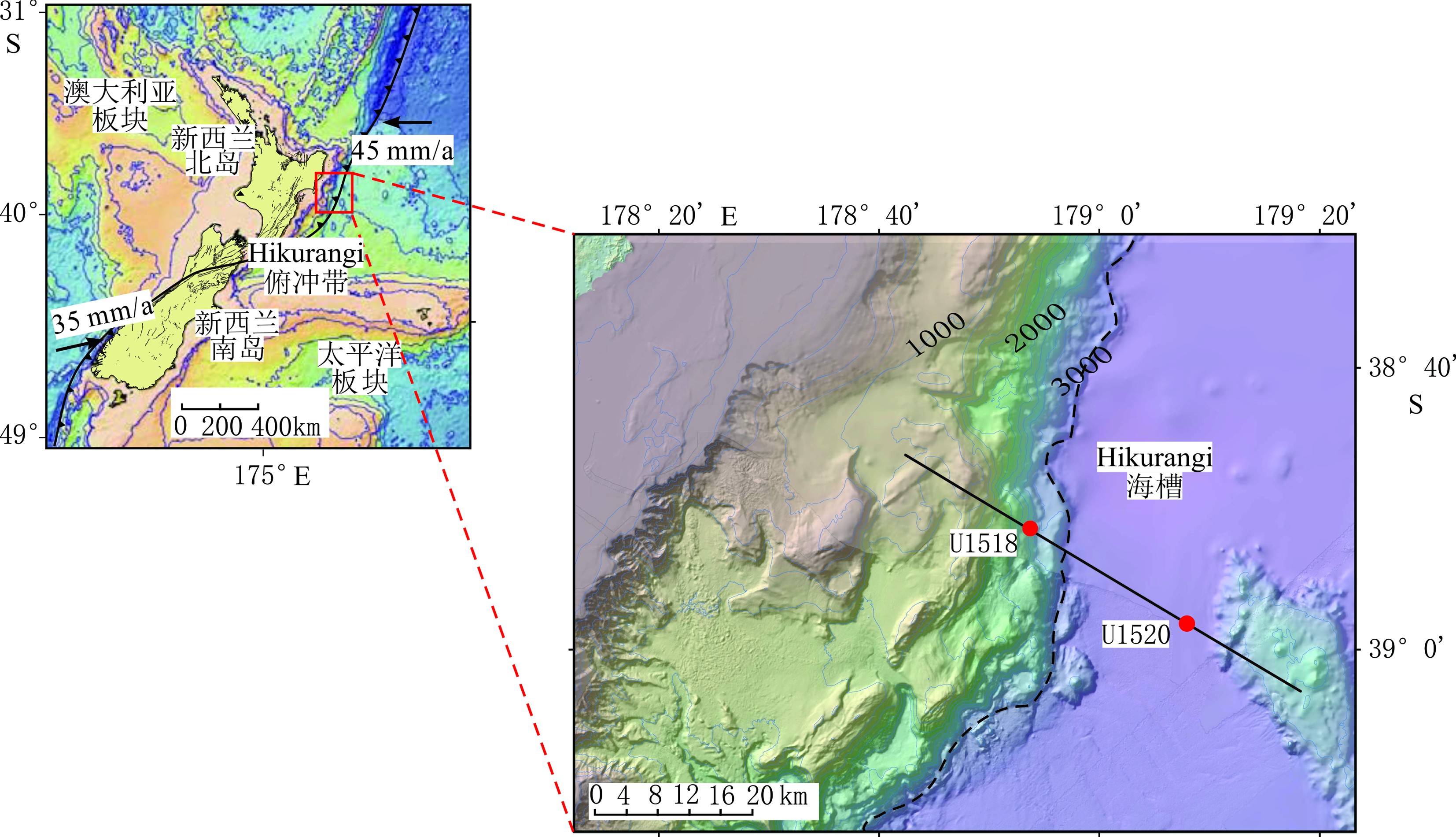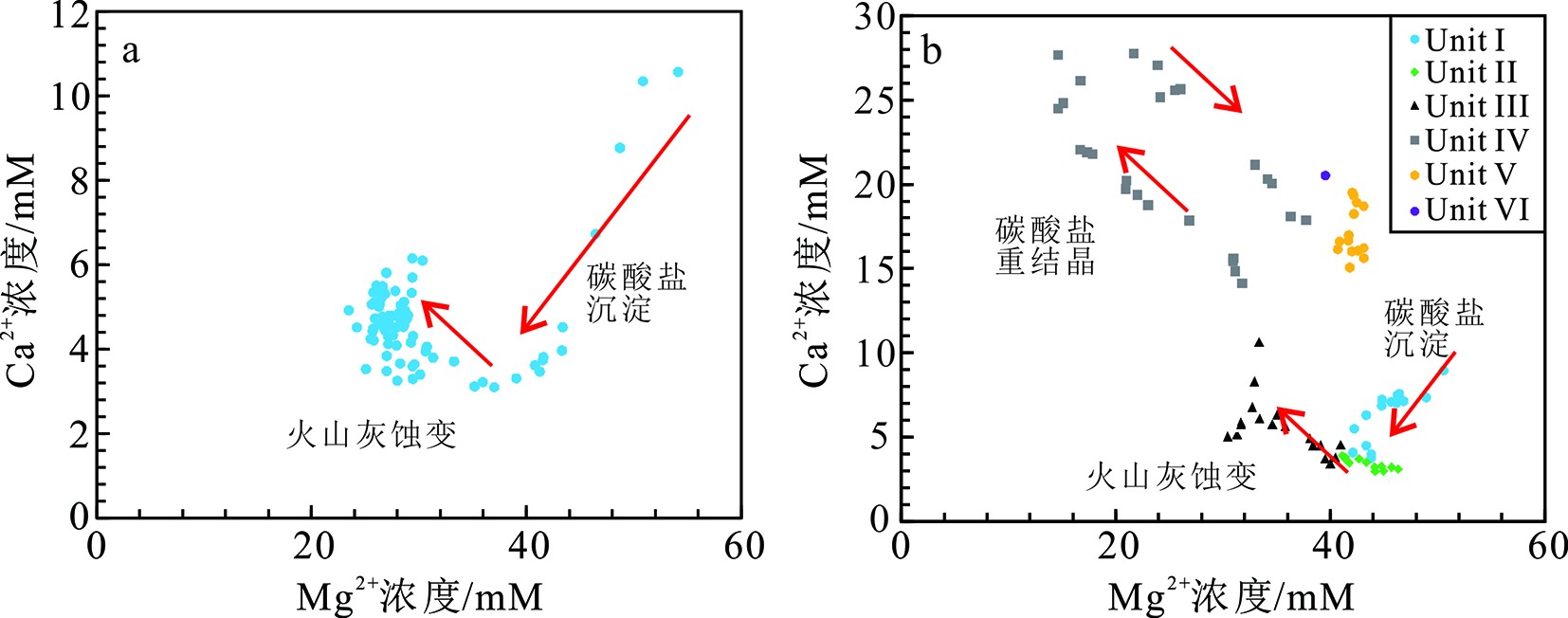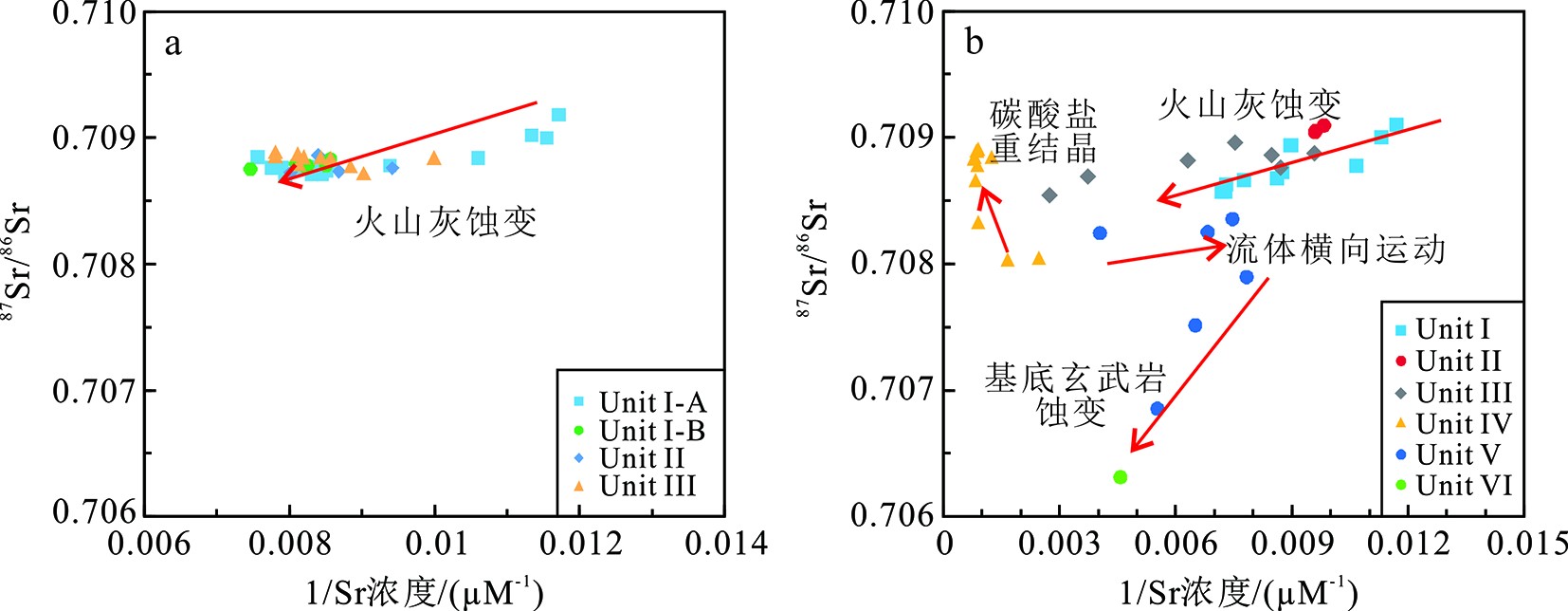A tracing study of sediment diagenesis in the Hikurangi subduction zone, New Zealand: Evidence from Sr isotope of pore fluid
-
摘要:
俯冲带是地球上地质活动最活跃的地带之一,对地球表面和内部的演化具有重要意义。俯冲带慢滑移事件作为一种重要的断层滑动方式在近十几年才逐渐被地球物理学家所认识。浅源慢滑移可以使浅部断层发生破裂至海底,引发大规模海啸。了解孔隙流体来源和俯冲带沉积物成岩作用有助于认识慢滑移事件的成因机制。以国际大洋发现计划(IODP)375航次在新西兰Hikurangi俯冲板块钻探站位(U1520)和变形前缘逆冲断层钻探站位(U1518)为研究对象,对两个站位沉积物孔隙流体的SO42-、Ca2+、Mg2+和Sr2+浓度以及放射性Sr同位素(87Sr/86Sr)进行了分析。结果显示两个站位Ca2+与Mg2+浓度、Sr2+浓度与87Sr/86Sr呈负相关关系是由于火山灰蚀变作用导致的。两个站位浅层0~14.3和0~37.3 mbsf沉积物孔隙水中的Ca2+、Mg2+浓度同时降低,表明发生了自生碳酸盐沉淀。同时,俯冲板块U1520站位的岩性单元IV(509.82~848.45 mbsf)Mg2+浓度随深度减小,Ca2+、Sr2+浓度则增加,但87Sr/86Sr基本保持不变,显示了碳酸盐重结晶作用。在其下部以火山碎屑岩为主的岩性单元V(848.45~1 016.24 mbsf)沉积物孔隙水的SO42-、Ca2+、Mg2+浓度均趋近海水值,这可能是由于海水在渗透性较好的火山碎屑岩中发生横向流动导致。因此,推测俯冲板片的岩性和成岩作用是高度的不均一,容易促使俯冲板片进入俯冲带后形成特殊的应力场和异常的流体压力,进而可能与Hikurangi俯冲带频发的慢滑移事件有关。
Abstract:The subduction zone, as one of the most active zones on Earth, has great significance in the evolution of Earth's surface and interior. Slow slip events have not been recognized as an important form of faulting by geophysicists until recent decades. Slow slip event occurring in shallow sediments can rupture the seafloor and trigger large-scale tsunamis. Understanding the source of pore fluids and the diagenesis of subduction zone sediments is helpful to understand the formation mechanism of slow slip events. This paper presents the results of SO42-, Ca2+, Mg2+ and Sr2+ and the radiogenic Sr isotope (87Sr/86Sr) on the pore fluid collected from the drilling sites on the subducting plate (Site U1520) and the deformation front (Site U1518) of the Hikurangi subduction margin, offshore New Zealand, drilled during the International Ocean Discovery Program IODP Expedition 375. The results show that Ca2+ and Mg2+ concentrations, Sr2+ concentration and 87Sr/86Sr ratio are negatively correlated, indicating the widespread occurrence of volcanic ash alteration at both sites. In addition, the simultaneous decrease of Ca2+ and Mg2+ concentrations in the pore waters of the shallow 0~14.3 and 0~37.3 mbsf sediments is due to authigenic carbonate precipitation. In addition, the significant decrease in Mg2+ concentration with depth and increase in both Ca2+ and Sr2+ concentrations with depth accompanied by relatively constant 87Sr/86Sr values at the lithologic Unit IV (509.82~848.45 mbsf) of Site U1520 point to the ongoing carbonate recrystallization. In the lithological Unit V (848.45~1016.24 mbsf) which is dominated by pyroclastic rocks, the SO42-, Ca2+, and Mg2+ concentrations in pore fluids are all close to seawater values. This observation likely implies the lateral flow of seawater-like fluid within the more permeable pyroclastic rocks compared to neighboring lithologic units. Therefore, we propose that the lithologic heterogeneity and various diagenetic processes of the subducting slab may lead to the formation of abnormal stress field and high fluid pressure after being subducted, which is likely related to the frequent occurrence of slow slip events in the Hikurangi subduction zone.
-
Key words:
- subduction zone /
- diagenesis /
- pore fluid /
- Sr isotope /
- slow slip
-

-
图 1 研究区和采样站位位置[27]
Figure 1.
-
[1] Stern J R. Subduction zones [J]. Reviews of Geophysics, 2002, 40(4): 1012. doi: 10.1029/2001RG000108
[2] Zheng Y F, Chen Y X. Continental versus oceanic subduction zones [J]. National Science Review, 2016, 3(4): 495-519. doi: 10.1093/nsr/nww049
[3] 唐盼, 郭顺. 绿帘石记录俯冲带变质流体活动[J]. 岩石学报, 2019, 35(7):2045-2060 doi: 10.18654/1000-0569/2019.07.07
TANG Pan, GUO Shun. Epidote records subduction-zone metamorphic fluid actions [J]. Acta Petrologica Sinica, 2019, 35(7): 2045-2060. doi: 10.18654/1000-0569/2019.07.07
[4] Davis D, Suppe J, Dahlen F A. Mechanics of fold-and-thrust belts and accretionary wedges [J]. Journal of Geophysical Research:Solid Earth, 1983, 88(B2): 1153-1172. doi: 10.1029/JB088iB02p01153
[5] Huene R V, Ranero C R, Vannucchi P. Generic model of subduction erosion [J]. Geology, 2004, 32(10): 913-916. doi: 10.1130/G20563.1
[6] Moore C J, Saffer D. Updip limit of the seismogenic zone beneath the accretionary prism of southwest Japan: An effect of diagenetic to low-grade metamorphic processes and increasing effective stress [J]. Geology, 2001, 29(2): 183-186. doi: 10.1130/0091-7613(2001)029<0183:ULOTSZ>2.0.CO;2
[7] Schnabel M, Flueh E R, Klaeschen D, et al. AVA analysis reveals in situ sediment diagenesis at the Costa Rican décollement [J]. Sedimentary Geology, 2007, 196(1-4): 269-277. doi: 10.1016/j.sedgeo.2006.06.003
[8] 于在平. 俯冲带的流体地质作用[J]. 地学前缘, 1995, 2(1-2):175-182
YU Zaiping. Fluids in subduction zones [J]. Earth Science Frontiers, 1995, 2(1-2): 175-182.
[9] Deyhle A, Kopf A, Frape S, et al. Evidence for fluid flow in the Japan Trench forearc using isotope geochemistry (Cl, Sr, B): Results from ODP Site 1150 [J]. Island Arc, 2004, 13(1): 258-270. doi: 10.1111/j.1440-1738.2003.00424.x
[10] Clough G W, Sitar N, Bachus R C, et al. Cemented sands under static loading [J]. Journal of the Geotechnical Engineering Division, 1981, 107(6): 799-817. doi: 10.1061/AJGEB6.0001152
[11] Karig D E. Reconsolidation tests and sonic velocity measurements of clay-rich sediments from the Nankai Trough [J]. Proceedings of the Ocean Drilling Program, Scientific Results, 1993, 131: 247-260.
[12] White R J, Spinelli G A, Mozley P S, et al. Importance of volcanic glass alteration to sediment stabilization: offshore Japan [J]. Sedimentology, 2011, 58(5): 1138-1154. doi: 10.1111/j.1365-3091.2010.01198.x
[13] Kameda J, Hina S, Kobayashi K, et al. Silica diagenesis and its effect on interplate seismicity in cold subduction zones [J]. Earth and Planetary Science Letters, 2012, 317-318: 136-144. doi: 10.1016/j.jpgl.2011.11.041
[14] Harris R, Yamano M, Kinoshita M, et al. A synthesis of heat flow determinations and thermal modeling along the Nankai Trough, Japan [J]. Journal of Geophysical Research:Solid Earth, 2013, 118(6): 2687-2702. doi: 10.1002/jgrb.50230
[15] Audet P, Bostock M G, Christensen N I, et al. Seismic evidence for overpressured subducted oceanic crust and megathrust fault sealing [J]. Nature, 2009, 457(7225): 76-78. doi: 10.1038/nature07650
[16] Bell R, Sutherland R, Barker D H N, et al. Seismic reflection character of the Hikurangi subduction interface, New Zealand, in the region of repeated Gisborne slow slip events [J]. Geophysical Journal International, 2010, 180(1): 34-48. doi: 10.1111/j.1365-246X.2009.04401.x
[17] Song T R A, Helmberger D V, Brudzinski M R, et al. Subducting slab ultra-slow velocity layer coincident with silent earthquakes in southern Mexico [J]. Science, 2009, 324(5926): 502-506. doi: 10.1126/science.1167595
[18] Veizer J. Strontium isotopes in seawater through time [J]. Annual Review of Earth and Planetary Sciences, 1989, 17: 141-167. doi: 10.1146/annurev.ea.17.050189.001041
[19] Teichert B M A, Torres M E, Bohrmann G, et al. Fluid sources, fluid pathways and diagenetic reactions across an accretionary prism revealed by Sr and B geochemistry [J]. Earth and Planetary Science Letters, 2005, 239(1-2): 106-121. doi: 10.1016/j.jpgl.2005.08.002
[20] Torres M E, Teichert B M A, Tréhu A M, et al. Relationship of pore water freshening to accretionary processes in the Cascadia margin: Fluid sources and gas hydrate abundance [J]. Geophysical Research Letters, 2004, 31(22): L22305.
[21] Mccarthy M, Zirkle B, Torres M E, et al. Data report: 87Sr/86Sr in pore fluids from Expedition 362[R]. Proceedings of the International Ocean Discovery Program, 2019, 362.
[22] Murray N A, McManus J, Palmer M R, et al. Diagenesis in tephra-rich sediments from the Lesser Antilles Volcanic Arc: Pore fluid constraints [J]. Geochimica et Cosmochimica Acta, 2018, 228: 119-135. doi: 10.1016/j.gca.2018.02.039
[23] Gieskes J M, Elderfield H, Palmer M R. Strontium and its isotopic composition in interstitial waters of marine carbonate sediments [J]. Earth and Planetary Science Letters, 1986, 77(2): 229-235. doi: 10.1016/0012-821X(86)90163-9
[24] Wallace L M, Beavan J, McCaffrey R, et al. Subduction zone coupling and tectonic block rotations in the North Island, New Zealand [J]. Journal of Geophysical Research:Solid Earth, 2004, 109(B12): B12406. doi: 10.1029/2004JB003241
[25] Pedley K L, Barnes P M, Pettinga J R, et al. Seafloor structural geomorphic evolution of the accretionary frontal wedge in response to seamount subduction, Poverty Indentation, New Zealand [J]. Marine Geology, 2010, 270(1-4): 119-138. doi: 10.1016/j.margeo.2009.11.006
[26] Wallace L M, Beavan J. Diverse slow slip behavior at the Hikurangi subduction margin, New Zealand [J]. Journal of Geophysical Research:Solid Earth, 2010, 115(B12): B12402. doi: 10.1029/2010JB007717
[27] Wallace L M, Saffer D M, Barnes P M, et al. Hikurangi subduction margin coring, logging, and observatories[R]. Proceedings of the International Ocean Discovery Program, 2019, 372B.
[28] Saffer D M, Wallace L M, Barnes P M, et al. Site U1518[R]. Proceedings of the International Ocean Discovery Program, 2019, 372B.
[29] Barnes P M, Wallace L M, Saffer D M, et al. Site U1520[R]. Proceedings of the International Ocean Discovery Program, 2019, 372B.
[30] Gieskes J M, Lawrence J R. Alteration of volcanic matter in deep sea sediments: evidence from the chemical composition of interstitial waters from deep sea drilling cores [J]. Geochimica et Cosmochimica Acta, 1981, 45(10): 1687-1703. doi: 10.1016/0016-7037(81)90004-1
[31] Gieskes J M. The chemistry of interstitial waters of deep sea sediments: Interpretation of deep sea drilling data[M]//Riley J P, Chester R. Chemical Oceanography. London: Academic Press, 1983, 8: 221-269.
[32] Hein J R, O'Neil J R, Jones M G. Origin of authigenic carbonates in sediment from the deep Bering Sea [J]. Sedimentology, 1979, 26(5): 681-705. doi: 10.1111/j.1365-3091.1979.tb00937.x
[33] Gieskes J M, Lawrence J R, Perry E A, et al. Chemistry of interstitial waters and sediments in the Norwegian-Greenland Sea, Deep Sea Drilling Project Leg 38 [J]. Chemical Geology, 1987, 63(1-2): 143-155. doi: 10.1016/0009-2541(87)90081-7
[34] Scholz F, Hensen C, Schmidt M, et al. Submarine weathering of silicate minerals and the extent of pore water freshening at active continental margins [J]. Geochimica et Cosmochimica Acta, 2013, 100: 200-216. doi: 10.1016/j.gca.2012.09.043
[35] Martin J B, Kastner M, Henry P, et al. Chemical and isotopic evidence for sources of fluids in a mud volcano field seaward of the Barbados accretionary wedge [J]. Journal of Geophysical Research: Solid Earth, 1996, 101(B9): 20325-20345. doi: 10.1029/96JB00140
[36] James R H, Palmer M R. Marine geochemical cycles of the alkali elements and boron: the role of sediments [J]. Geochimica et Cosmochimica Acta, 2000, 64(18): 3111-3122. doi: 10.1016/S0016-7037(00)00418-X
[37] Mcduff R E, Gieskes J M. Calcium and magnesium profiles in DSDP interstitial waters: Diffusion or reaction? [J]. Earth and Planetary Science Letters, 1976, 33(1): 1-10. doi: 10.1016/0012-821X(76)90151-5
[38] Lyons T W, Murray R W, Pearson D G. 19. A comparative study of diagenetic pathways in sediments of the Caribbean Sea: highlights from pore-water results [J]. Proceedings of the Ocean Drilling Program, Scientific Results, 1995, 165: 287-298.
[39] Gieskes J M, Vrolijk P, Blanc G. Hydrogeochemistry, ODP Leg 110: An Overview [J]. Proceedings of the Ocean Drilling Program, Scientific results, 1986, 110: 395-408.
[40] Aller R C. Sedimentary diagenesis, depositional environments, and benthic fluxes[M]//Holland H D, Turekian K K. Treatise on Geochemistry. 2nd ed. Amsterdam: Elsevier Ltd., 2014, 8: 293-334.
[41] Hesse R, Schacht U. Early diagenesis of deep-sea sediments [J]. Developments in Sedimentology, 2011, 63: 557-713.
[42] Joseph C, Torres M E, Martin R A, et al. Using the 87Sr/86Sr of modern and paleoseep carbonates from northern Cascadia to link modern fluid flow to the past [J]. Chemical Geology, 2012, 334: 122-130. doi: 10.1016/j.chemgeo.2012.10.020
[43] Sample J C, Torres M E, Fisher A, et al. Geochemical constraints on the temperature and timing of carbonate formation and lithification in the Nankai Trough, NanTroSEIZE transect [J]. Geochimica et Cosmochimica Acta, 2017, 198: 92-114. doi: 10.1016/j.gca.2016.10.013
[44] Perry E A Jr, Gieskes J M, Lawrence J R. Mg, Ca and exchange in the sediment-pore water system, hole 149, DSDP [J]. Geochimica et Cosmochimica Acta, 1976, 40(4): 413-423. doi: 10.1016/0016-7037(76)90006-5
[45] Higgins J A, Schrag D P. Records of Neogene seawater chemistry and diagenesis in deep-sea carbonate sediments and pore fluids [J]. Earth and Planetary Science Letters, 2012, 357-358: 386-396. doi: 10.1016/j.jpgl.2012.08.030
[46] Saffer D M, Tobin H J. Hydrogeology and mechanics of subduction zone forearcs: Fluid flow and pore pressure [J]. Annual Review of Earth and Planetary Sciences, 2011, 39(1): 157-186. doi: 10.1146/annurev-earth-040610-133408
[47] Saffer D M, Wallace L M. The frictional, hydrologic, metamorphic and thermal habitat of shallow slow earthquakes [J]. Nature Geoscience, 2015, 8(8): 594-600. doi: 10.1038/ngeo2490
[48] Torres M E, Cox T, Hong W L, et al. Crustal fluid and ash alteration impacts on the biosphere of Shikoku Basin sediments, Nankai Trough, Japan [J]. Geobiology, 2015, 13(6): 562-580. doi: 10.1111/gbi.12146
[49] Morgan J K, Karig D E, Maniatty A. The estimation of diffuse strains in the toe of the western Nankai accretionary prism: A kinematic solution [J]. Journal of Geophysical Research:Solid Earth, 1994, 99(B4): 7019-7032. doi: 10.1029/93JB03367
[50] Saidi F, Bernabé Y, Reuschlé T. The mechanical behaviour of synthetic, poorly consolidated granular rock under uniaxial compression [J]. Tectonophysics, 2003, 370(1-4): 105-120. doi: 10.1016/S0040-1951(03)00180-X
[51] Schnaid F, Prietto P D M, Consoli N C. Characterization of cemented sand in triaxial compression [J]. Journal of Geotechnical and Geoenvironmental Engineering, 2001, 127(10): 857-868. doi: 10.1061/(ASCE)1090-0241(2001)127:10(857)
[52] Spinelli G A, Mozley P S, Tobin H J, et al. Diagenesis, sediment strength, and pore collapse in sediment approaching the Nankai Trough subduction zone [J]. GSA Bulletin, 2007, 119(3-4): 377-390. doi: 10.1130/B25920.1
[53] McDuff R E. Major cation gradients in DSDP interstitial waters: the role of diffusive exchange between seawater and upper oceanic crust [J]. Geochimica et Cosmochimica Acta, 1981, 45(10): 1705-1713. doi: 10.1016/0016-7037(81)90005-3
-




 下载:
下载:



